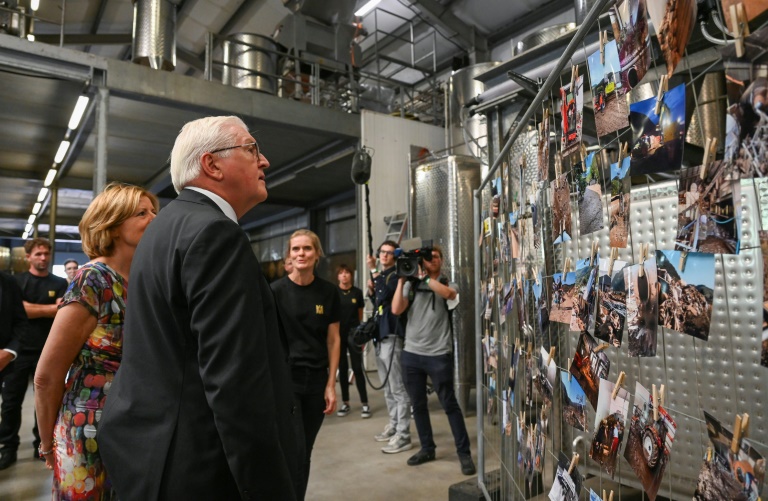Germany on Thursday paid tribute to more than 180 people killed in severe floods a year ago, as those left behind charged that help with the reconstruction effort has been too slow to arrive.
President Frank-Walter Steinmeier embarked on a tour of the Ahr valley in the morning, while Chancellor Olaf Scholz was due to attend a memorial ceremony in hard-hit Bad Neuenahr-Ahrweiler later in the day.
In the town of Altenahr, Steinmeier said he wanted to “show that we haven’t forgotten the people of the Ahr valley” and “how many are still struggling to rebuild their homes”.
In nearby Dernau, gardener Wilhelm Hartmann, 49, said he had been averaging two hours’ sleep a night for the past 12 months while working as a volunteer for the relief effort.
“There have been so many emotional moments,” he said, hailing the region’s “great network” of willing helpers.
However, a year on from the disaster, frustration is building at the sluggish pace of help promised by the government.
Alfred Sebastian, the mayor of Dernau, said the town was “still at the very beginning” of the reconstruction process.
“We need to be financially supported by the state… We need it now. If not now, when? We have to move forward,” he said.
– Trail of destruction –
Severe floods pummelled western Germany over two days in July last year, ripping through entire towns and villages and destroying bridges, roads, railways and swathes of housing.
Between 100 and 150 millimetres (four and six inches) of rain fell between July 14 and 15, according to the German weather service — an amount that would normally be seen over two months.
Forecasters had issued warnings, yet many residents were simply unaware of the risks of such violent flooding, with dozens found dead in their cellars.
With former chancellor Angela Merkel still in charge at the time of the floods, the government pledged a total of 30 billion euros ($30 billion) in federal and state aid to help with the reconstruction effort.
But in the state of Rhineland-Palatinate, only 500 million euros in aid has been handed out of the total 15 billion euros set aside.
In neighbouring North Rhine-Westphalia, 1.6 billion euros of government support has been approved for use, out of a total of 12.3 billion euros.
The disaster prompted criticism of Germany’s flood warning system and a criminal inquiry was opened into local officials for “negligent homicide”.
The government has since pledged to introduce phone alerts in the form of “cell broadcasting” and to reinstall sirens, many of which have been taken down in recent years.
– Climate concerns –
Introducing a new disaster management plan on Wednesday, Interior Minister Nancy Faeser admitted there had been “major failures over the past years and decades”.
The government is planning a new annual civil protection day from 2023 to raise awareness of how to respond in a disaster and “make our country more crisis-proof”, Faeser said.
The disaster also raised concerns about climate change, with one international study showing that man-made global warming had made the floods up to nine times more likely.
A year on, Germany is set for more extreme weather with temperatures of up to 40 degrees Celsius (104 degrees Fahrenheit) expected this week as a heatwave sweeps across Europe.
Ralph Tiesler, president of the BBK federal disaster management agency, told the Funke media group on Wednesday he believed some areas in Germany may become uninhabitable due to extreme weather events.
“I say that some areas should not be resettled due to climate change and the acute threat of severe weather disasters and floods,” he said.
In neighbouring Belgium, where 39 people were also killed in the deluge, King Philippe and Queen Mathilde attended a ceremony in Liege.
Belgian Prime Minister Alexander De Croo paid tribute to the “heroes” who came to the aid of the victims, including a 14-year-old boy who threw himself into a river in an unsuccessful attempt to save a fellow scout camp member.









